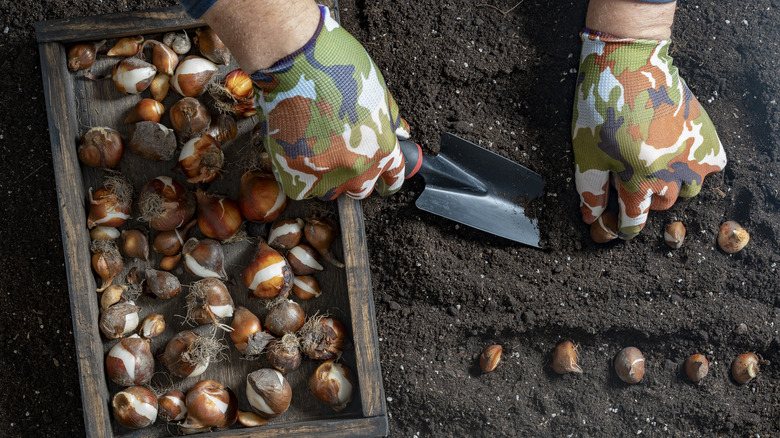Should You Plant Tulips In October? What To Do For Gorgeous Spring Blooms
October is the season for apple picking, pumpkin spice lattes, and crunchy leaves. And while you get into your favorite sweater and get your home ready for fall with fun DIYs and decorations, the last thing on your mind is spring flowers. But the truth is, October is the perfect time to plant tulips. If you want gorgeous spring blooms, the fall is when you need to get your hands dirty. That's because tulip bulbs need to spend time in the cold to kickstart their blooming process, a process called "cold dormancy," which naturally happens in winter. Planting in October means you're giving them enough time to establish some roots before winter rolls around and the bulbs go to sleep until spring. Come the spring, you'll be so glad you got your hands dirty to get those bulbs in the ground.
In USDA Hardiness Zones 3 through 6, the window to plant tulip bulbs starts in late September and goes through October into early November. Essentially, you need the soil temperatures to drop to around 40 to 50 degrees Fahrenheit, but you need to get the bulbs into the ground before it freezes and becomes too hard to work with. In southern states (specifically USDA Hardiness Zones 7b through 10), that means bulbs can go in the ground a bit later, but to mimic cooler temperatures, you'll need to place them in the fridge in October for about six to 12 weeks before planting, typically sometime in December or January. So while you might be tempted to stay warm and make great Halloween decor, don't forget to add a bit of gardening to your fall to-do list. It's a small effort that will bring tons of colorful rewards when spring finally comes around.
How to plant tulip bulbs in the fall
Tulips love the sun, but they don't like heat. Therefore, it's best to plant in a sunny spot, since temperatures remain low between October and March. However, in warmer parts of the United States, like Zone 8, it's best to choose an area that gets sun only in the morning to prevent the flowers from overheating in the afternoon. Keep in mind that tulips don't like sitting in damp soil, so you need well-draining soil. If needed, you can improve heavy clay soil in your garden with organic matter, like compost. Adding sand can also be a simple soil boost that will help your tulips thrive and avoid bulb rot.
Once you have your spot all picked out, it's time to plant. Grab a shovel, and dig about 8 inches into the ground where you want to plant the tulips. Then, place the bulbs into the holes with the pointed part facing upward. The bulbs can be as close as 4 inches from each other, but you can space them out more if you'd like a less dense flowerbed. Cover the bulbs back with the soil you dug up, gently, to make sure you're not toppling any of them over. Tamp down the soil lightly to firm it up, and water it.
To ensure the bulbs grow, keep an eye on the weather. If it rains, no need to water, but you can step in when the weather is particularly dry (two or three weeks without rain). If you'd like to protect the bulbs from animals like squirrels, consider adding a bit of chicken wire on top of the soil. Weigh it down with a brick or a rock, and only remove it when the plants start to emerge in the spring.

